The latest blockbuster from the couple behind Bestia and Bavel roars with ambition
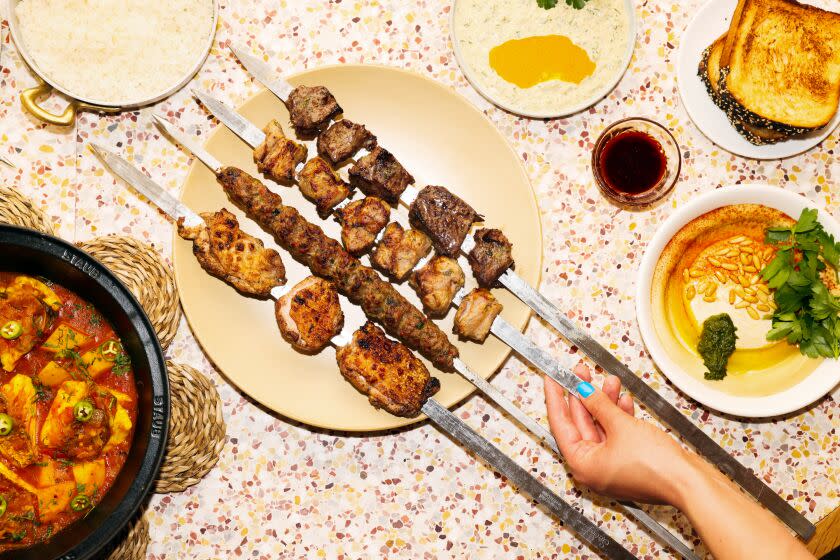
It’s hard to forget Ori Menashe’s hummus after tasting it for the first time. He achieves a creaminess, writ in chickpeas and tahini, on par with Jöel Robuchon’s famous pommes puree. His mastery of the dip rewired diners’ synapses when he and his wife, pastry chef Genevieve Gergis, opened Bavel in the Arts District in 2018, six years after the launch of their nearby Italian blockbuster Bestia.
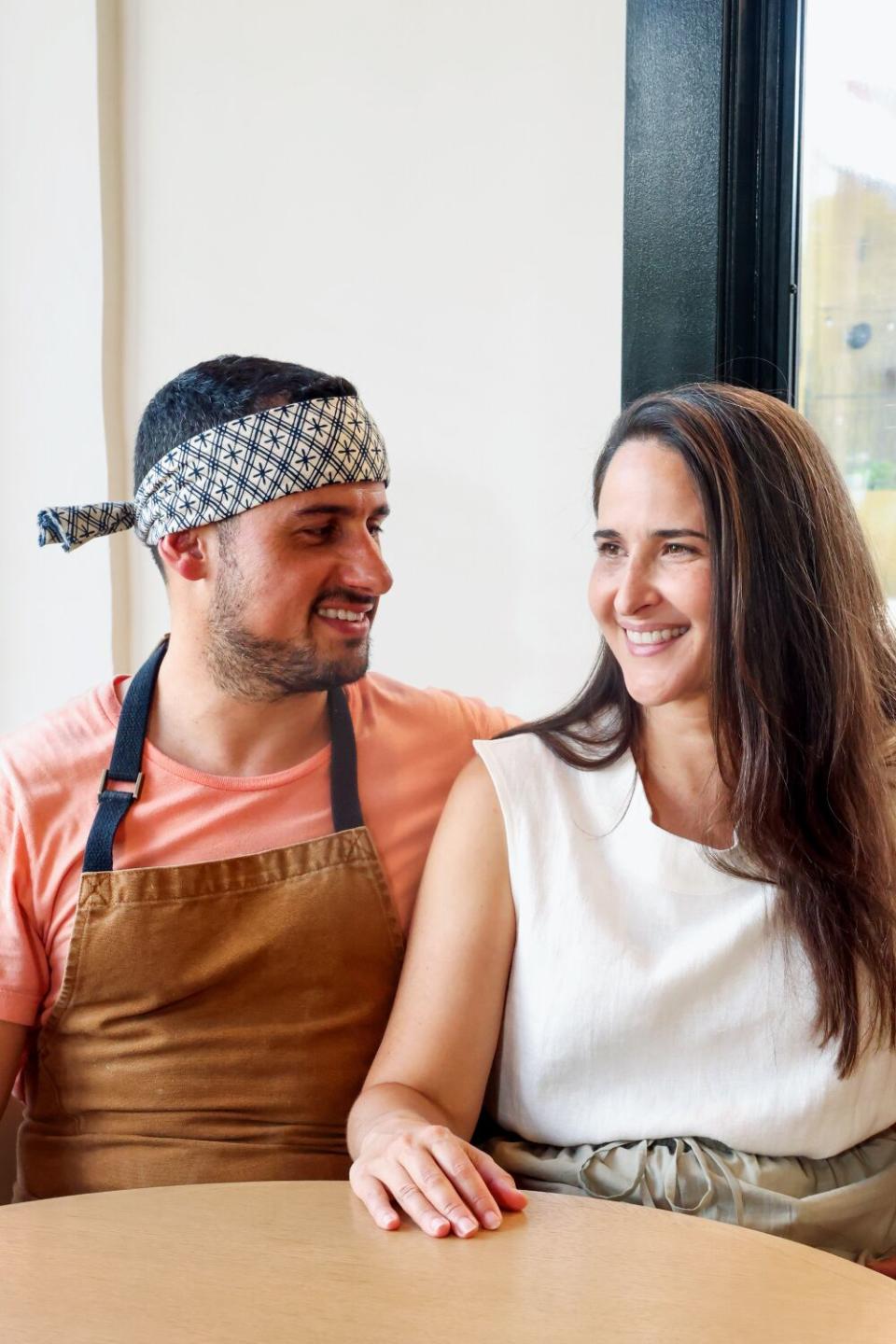
Menashe’s talents with the dish have a fresh platform at Saffy’s, the couple’s new kebab and small plates restaurant in East Hollywood named for their daughter Saffron.
As at Bavel, Saffy’s menu lists two hummus options. The flashier of the pair includes a dollop of long-simmered fava beans brightened with lemon and fermented serrano chiles; a soft-boiled egg perches on the side as a bonus, halved to reveal its jammy insides and sprinkled with cumin and big flakes of salt. It’s an advanced course in subtle contrasts: the way the mulchy favas melt into the blitzed chickpeas; the interplay of earthy flavors; and how a pool of good olive oil can flatter and unite all the ingredients it bathes.
But then there is the hummus tahini. A quenelle-shaped garnish of green zhoug, the Yemeni hot sauce rendered here more herbal than scorching, brings in the acidic jolt that Menashe favors. The real clincher, though, is the handful of pine nuts scattered over the top. The cost of exquisite pine nuts — long and tapered rather than short and squat, buttery and with the freshest ones hinting of resin — has lately skyrocketed. The ones used in Saffy’s kitchen, with their dissolving crunch, come from the south of Lebanon; savoring even a couple of them in each bite makes for a rare treat.
Both versions arrive with two thick, crisped slices of challah crusted with black and white sesame seeds. I don’t want to see the traditional khubz (Arabic flatbread) or pita broadly replaced as accompaniments, but the pleasure of swiping crisped, egg-rich toast through drifts of hummus is undeniable.
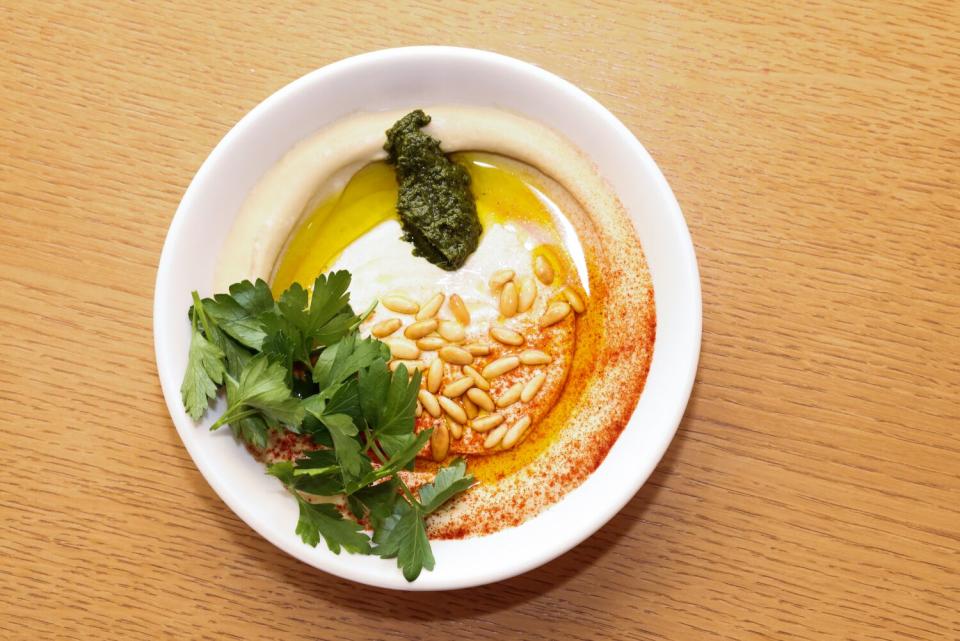
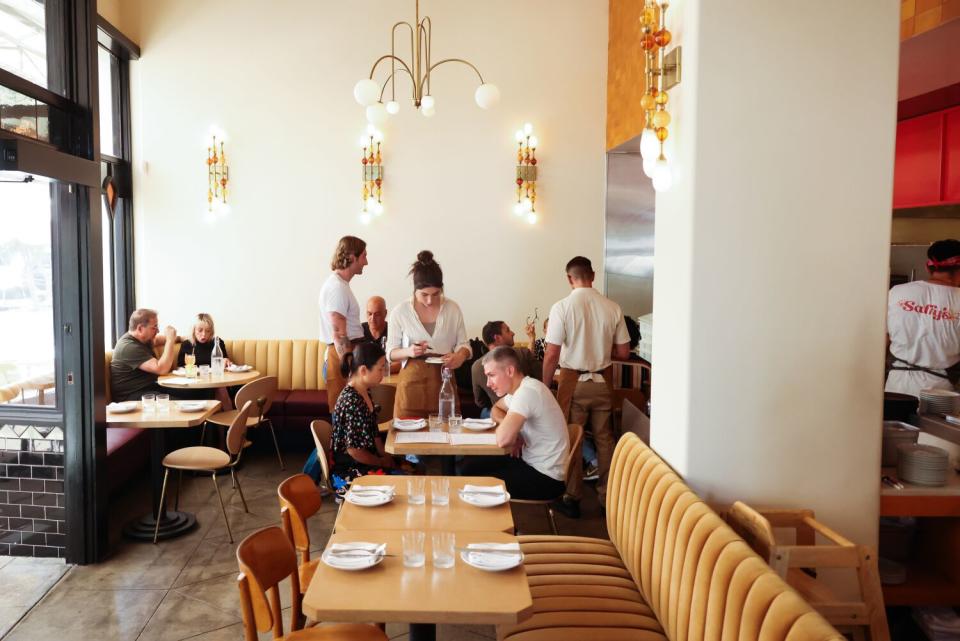
Details like these make Saffy’s another victory for Menashe and Gergis.
When the restaurant opened in early June, focusing on kebabs with a dozen or so California-inflected salads and starters, it may have appeared that the duo was striving for something more casual among their growing businesses. The Art Deco space in the Merrick Building — which housed the short-lived Brooklyn import Five Leaves and sits across the street from the Church of Scientology’s “Big Blue” building — has a slightly more informal air than its older siblings, true. This is a smaller room, though boomingly loud like the others; a recently installed awning that stretches nearly to the curb added significant, quieter outdoor seating.
Really, though, the place roars with ambition. It’s evident in the fleet of single-minded chefs, their foreheads covered by multicolored bandannas, a Menashe signature, and in the finesse of the service staff, many of whom worked at Bestia or Bavel for years. It’s unmistakable in the precision of the cooking that channels the spice-fragrant, sun-soaked flavors of Western Asia (a.k.a. the Middle East, though many friends and peers from the area increasingly rebuff the term) and North Africa.
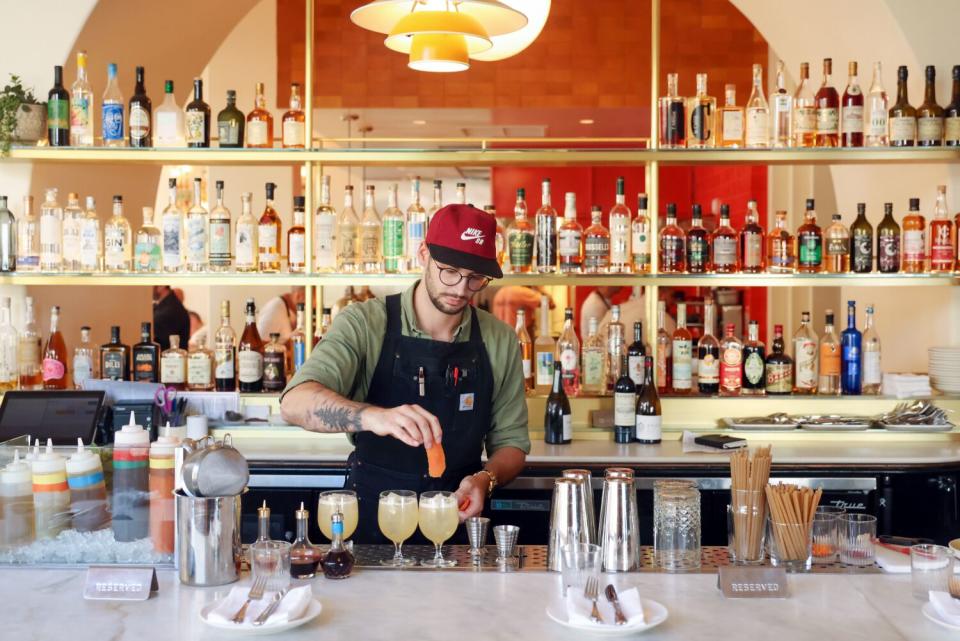
One can argue how “casual” may be best defined these days; I certainly wouldn’t label Saffy’s as inexpensive. Overall Menashe and Gergis don’t quite seem capable of a stripped-down, laidback, dialed-in style of restaurateuring. It’s largely to our gain.
The corner of Fountain Avenue and North Catalina Street is the place to be in Los Angeles mid-2022. You can see the crowd filling the sidewalk from blocks away. Join them. Soon you’re shouting in conversation among the dining room’s pink and earth tones — the gilded geometrics of the booths and light fixtures recall glamorous magazine stills of Beirut or Marrakesh in their 1960s eras — or breathing a little easier at a table outside. Cocktails, like tequila-spiked cherry limeade or a Vesper spritzed with rose water and lemon oil, appear quickly and often disappear just as swiftly.
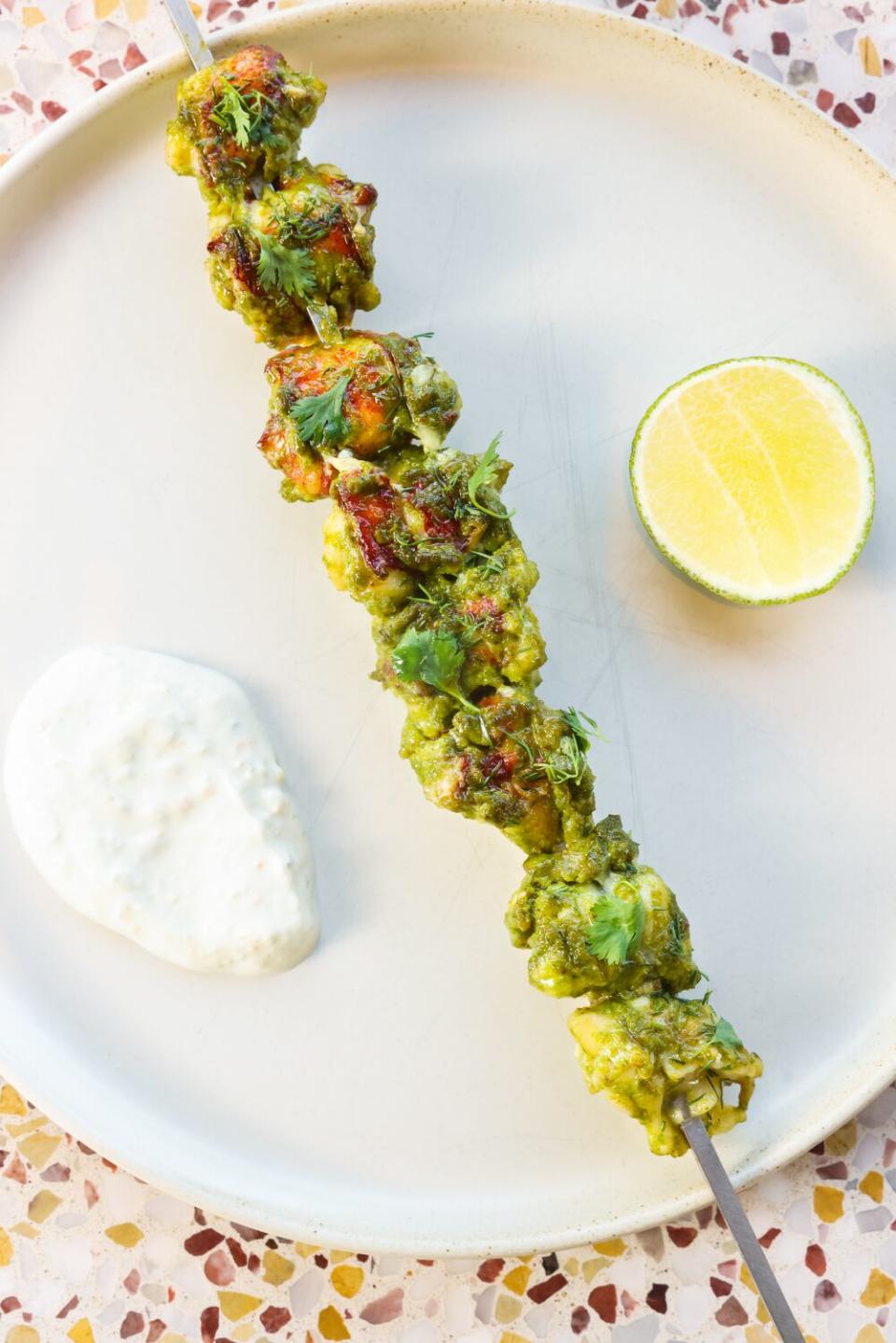
If you know Bavel, you’ll recognize the same master formula at Saffy’s: a grab bag of flavors expressing the couple’s upbringings (Gergis’ family is of Egyptian ancestry; Menashe grew up in Israel and also has Turkish and Moroccan roots), meats cooked over burning wood, California inspiration.
Salads play well alongside hummus. A flecked ring of smoky eggplant puree cradles a juicy heap of chopped tomatoes dotted with milky feta and nigella seeds; cinnamon shimmers distantly like heat rising over the horizon. Preserved Meyer lemon and the woodsy sweetness of ras el hanout bring spark to the familiar pairing of carrots and yogurt.
Break open the falafel; it is the green of a tea garden in spring. An appetizer of grilled lobster has been threaded onto a skewer as a prelude to the meatier courses ahead. Slathered in a mix of green harissa and lime-scented yogurt without overpowering the lobster’s sweetness, it's a splurge at $32 … and also the most compelling use of that costly seafood I’ve consumed so far this decade.
Perhaps you might also initially balk at the price of the shawarma. It costs $26. Walking into the restaurant you can’t help but notice the open kitchen’s center-stage vertical spit, slowly revolving as glowing logs baptize the meat in smoke and fire. Chefs shave off the strips of beef and lamb, wrapping them in thin laffa spread with tahini and red ajika (a mildly spicy Georgian bell pepper jam) and layered with tomato, sumac onions and a single, unobtrusive leaf of lettuce. The ingredients sing as a choir. I love shawarma in all iterations. This one earns its place.
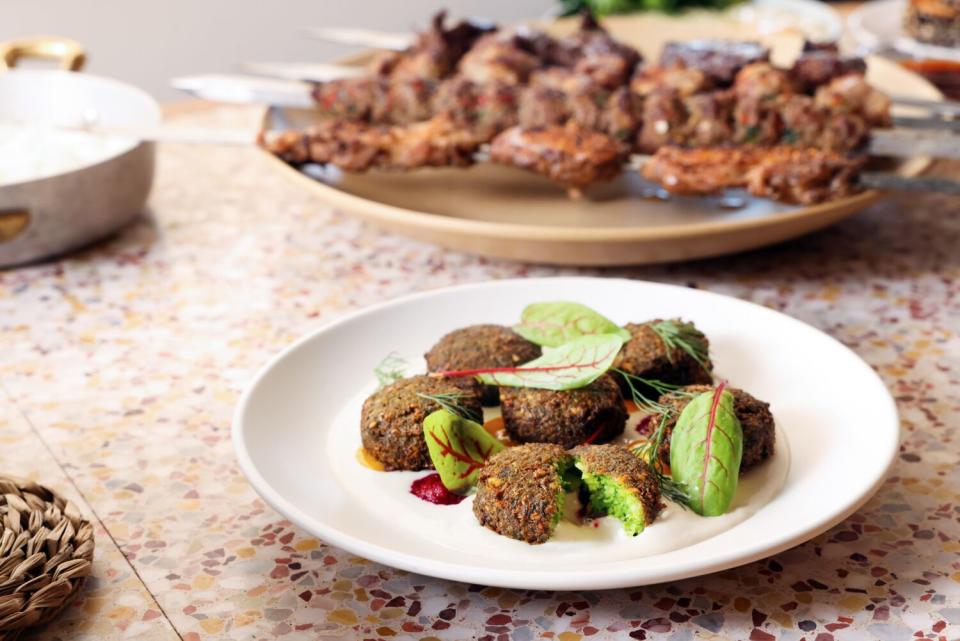
As for the kebabs, choose among lamb, chicken, beef or pork. I favor lamb, fluctuating between a black-pepper-and-cardamom-scented version with visible veins of parsley and onion, and a variation heady with dried mint and marjoram and lightened by minced sweet peppers. For another seasoning angle altogether, try the chicken shashlik with its musk of dried spices: cumin, fenugreek, sumac and cinnamon. Servers will instruct you to slide the meats off the heavy, sword-sharp skewer using laffa as an edible oven mitt, though the bread itself can at first scorch the fingers. Staffers discreetly remove the metal spikes immediately; no “House of the Dragon” shenanigans encouraged.
Kebabs come with a very Angeleno array of condiments: an herbed tahini salad that evokes Green Goddess dressing; tangy, vivid-orange amba running over the top like runaway mango pickle lava; and a small tea cup's worth of crimson chile crisp. You may lose yourself in trying various groupings of tastes and textures. You will hopefully emerge as sated as I have each meal.
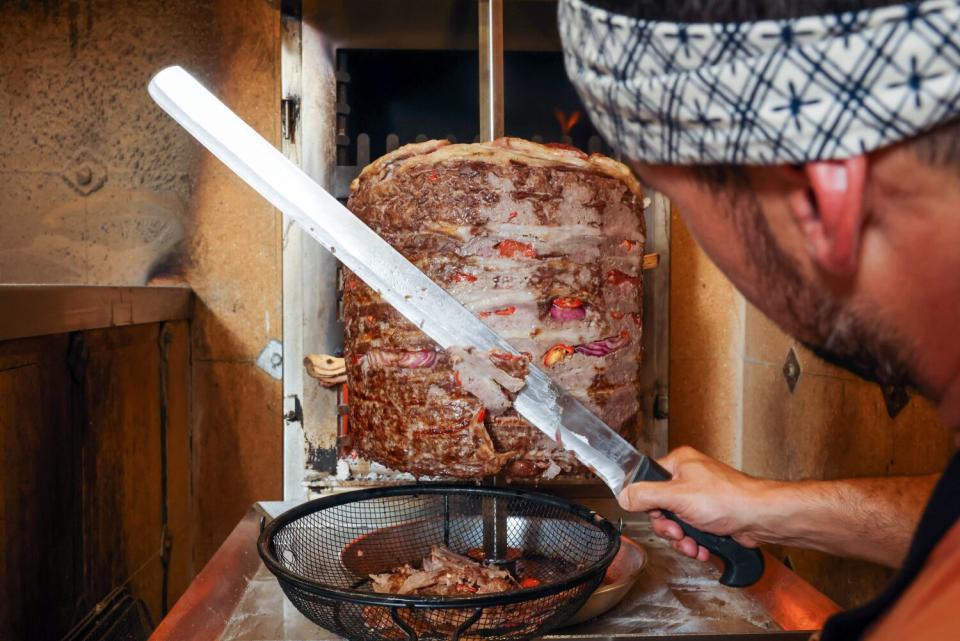
Among the large-format mains for sharing, a $65 “dish kebab” combines influences from Turkey and Pakistan to create a dish of roasted ground beef and lamb, with minced lamb for textural nuance. Beet greens, petals of pearl onion and sliced tomatoes have been strewn over the meat; sides of turmeric rice and yogurt make it a complete meal. It’s intriguing, and I’d say come first for the shawarma and kebabs and try this on a second or third visit. I feel similarly about the gentle gingered fish tagine served with coconut rice.
Desserts, admittedly, run casual, including a swirl of seasonal soft-serve ice creams (peach and raspberry was the big summer hit) and crème caramel perfumed with orange blossom. A handsome slice of chocolate cake, crowned with a correct, generous ratio of ganache, lands at most tables.
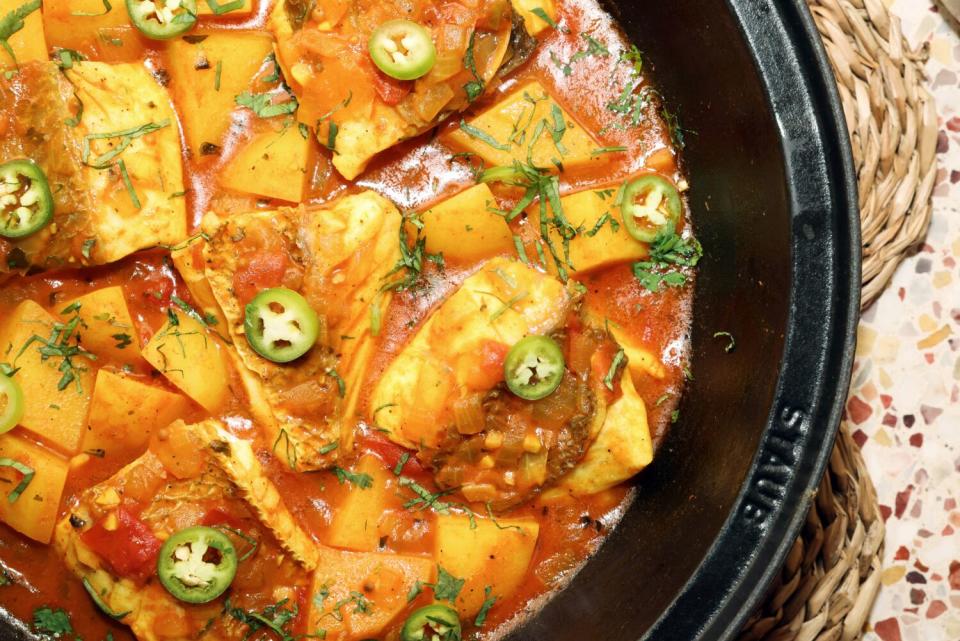
Gergis and Menashe have plans to start daytime service at Saffy’s, and next door they’ve opened a storefront for coffee, tea and a limited number of baked goods. Among cookies, spiced potato bourekas and blueberry coffee cakes, the early standouts are the short, crisp buttermilk biscuits, served savory with ham, cheese and mustard aioli or sweet with butter and berry jam. Loaves of the challah served with the hummus also are available.
The bakery draws intermittent crowds so far. It gives Gergis and Menashe something to strive for, since their newest restaurant has — predictably for their track record — reached the height of its powers almost immediately.
This story originally appeared in Los Angeles Times.

